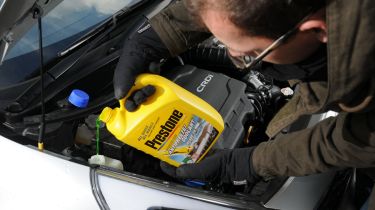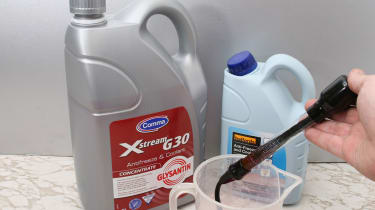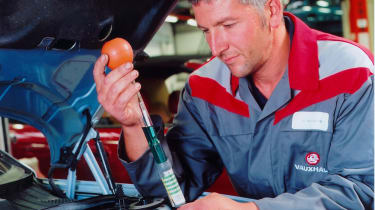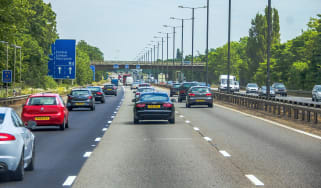Engine coolant and antifreeze: which antifreeze should I pick?
Coolant – or antifreeze – helps keep your engine running at the right temperature. Here’s what you should know
Your car’s engine uses coolant, also known as antifreeze, to keep it running at the right temperature. A dashboard warning light will illuminate if your car is running low on coolant, but it’s important to regularly check that it’s topped up to the correct level. Running an engine without enough coolant puts it at risk of overheating, which could lead to serious – and expensive – damage.
 Engine management light: what to do if it comes on
Engine management light: what to do if it comes on
There are two general types of antifreeze to be aware of, but once you’ve picked the correct bottle, it’s pretty straightforward to top up yourself – we’ll cover how to do this further down. For more advice on how to maintain your car, read our guides to Adblue and choosing the best engine oil.
What does coolant do?
Coolant is used to regulate the temperature of your car’s engine and prevent it from overheating. It is pumped around the engine, where it absorbs heat, and through the radiator, where the heat is transferred to the surrounding air.
What we generally refer to as ‘coolant’ is a mixture of water and antifreeze. As the name suggests, antifreeze prevents the water from freezing in cold conditions but it’s also responsible for lubricating the pump that directs coolant around the engine. For this reason, you should never use tap water alone in your car’s cooling system.
Coolant is used in liquid-cooled engines, so is found in every new petrol, hybrid or diesel-powered car you can buy today. Some air-cooled classics such as the Citroen 2CV, original Volkswagen Beetle and pre-1998 Porsche 911 don’t need any coolant. Some electric vehicles don’t need it either, although some of the more sophisticated models (such as a Tesla Model S and Audi e-tron) do have coolant fluid to help reduce battery temperature while charging.
How does antifreeze work?
Antifreeze is a component of your car’s cooling system. It’s a liquid that’s mixed with water, combining to make what we call ‘coolant’. Antifreeze is used to stop water freezing in very cold conditions.
The mixture is pumped around the engine by the water pump. As it passes through hotter parts of the engine, the coolant absorbs the heat until it reaches the radiator. The cold air that rushes through the radiator reduces the temperature of the coolant as the car drives along. A fan will cut in if the car is stuck in traffic and the temperature rises. After passing through the radiator, the coolant – now at a lower temperature – is fed back through the engine where the process starts again.
Without antifreeze, the coolant could freeze during winter months, preventing it from flowing around the engine, causing blockages and also expansion damage. When antifreeze is added to water, it lowers its freezing point as well and increases its boiling point. If your coolant contains the right concentration of antifreeze, your engine will be protected against almost any weather the UK can throw at it.
What types of antifreeze are there?
Two types of antifreeze are widely available, but not all makes and models of car are compatible with both. If you’re unsure of which antifreeze you need, check your car’s handbook or ask your local dealership.
Antifreeze is sold as either ‘organic acid technology’ (OAT) or non-OAT. OAT antifreeze is typically suited to cars built from 1998 onwards as it provides good corrosion protection for aluminium components. Cars built before 1998 are usually better off with non-OAT-based antifreeze, which better protects copper and brass components. This is sometimes referred to as glycol antifreeze.
There are also different colours of antifreeze to consider, with each colour corresponding to a different formulation. Particular colours of antifreeze are intended to work in specific cooling systems, so they’re not always interchangeable – we recommend checking your handbook to see which one you need.
Sometimes two non-compatible types of antifreeze won’t mix together correctly. When this happens, they can combine to create solid lumps or gels, which could potentially block the cooling system if the problem isn’t spotted and resolved early.
If you’re in any doubt, it’s always wise to consult the owner's manual for your car or contact your dealer. Alternatively, most car spares shops should be able to sell you the correct antifreeze for your car. To do this, they’ll need the exact details of your car, including its make, model, engine size, fuel type and year of manufacture.
You can buy antifreeze ready mixed to be added straight to your car, or as a concentrate that you can mix with water before adding it to your engine. The bottle will have instructions and mixture ratios printed on it – e.g. one part coolant to four parts water is the same as a 20% ratio of coolant to water.
How do I check my coolant?
To check your coolant, first make sure you have located the right tank under your bonnet – modern cars have several that look similar, so consult your handbook if you’re not sure. The liquid inside should be a bright colour and there should be markings on the tank that indicate the correct level of coolant. If your level is sitting below this, it will need to be topped up when the engine is cool – never open the coolant reservoir when the engine is hot, as this can be dangerous.
Sometimes, your coolant will need to be replaced entirely. If your coolant has lumps in it or is a dull brown colour, it’s likely to need changing. However, even crystal-clear coolant can lose its effectiveness against corrosion over time. An antifreeze tester will tell you whether it’s still doing its job correctly.
You can buy an antifreeze tester from most good car accessory shops. The cheapest type is a hydrometer (sometimes called a float tester) and these start at less than five pounds. A refractometer is more expensive at up to £50, but provides greater accuracy.
Although the two types work differently, both will tell you how cold your coolant can go before it’ll freeze. Most antifreeze provides an operating range from over 100 degrees Celsius down to below minus 30 degrees Celsius. The normal operating temperature of most car engines is around 90 degrees Celsius.
Can I drive without coolant?
In all but a handful of air-cooled cars, coolant is necessary to prevent your car’s engine from overheating. Driving without coolant will cause your engine temperature to rise and could cause significant damage.
Usually a dashboard warning light will illuminate before this point, altering the driver to the high temperature and reminding them to top up the coolant. Sometimes, you’ll see steam rising out of the bonnet if the engine has overheated, as well.
If you ignore the warning and continue to drive without coolant, it can lead to problems with parts of the engine, including the heads, head gaskets and the block itself. Major problems with these are likely to lead to huge repair bills or the car being written off.
Can I use water instead of coolant?
No. Never use water from a tap, hose or bottle in your cooling system. As well as offering protection against boiling and freezing conditions, proper coolant has a much reduced risk of corroding the metal parts of your engine that it contacts. The water pump, radiator and heating system, as well as the engine itself, can all corrode in prolonged contact with normal tap water.
If you’ve bought concentrated antifreeze, you’ll need to mix it with water following the instructions supplied. If you live in a hard water area (you’ll have noticed scale around your taps and in your kettle if you do), you should mix the antifreeze with distilled water, which has fewer impurities than tap water.
How do I top up car coolant/antifreeze?
Once you’ve tested your antifreeze and determined that it needs topping up, rather than replacing, you can fill up the tank to somewhere between the ’min’ and ‘max’ lines. Make sure to use the same type and colour of antifreeze and to mix it with water to the specified ratio if required. If your coolant level is regularly dropping between services, then you may have a leak and it’s worth investigating.
You should also top up fluids like antifreeze before storing the car off the road for longer periods of time. Check out our guide on how to store a car for more info.
Changing antifreeze
Your local garage will be able to change your antifreeze for between £50 and £100 with a flush of your car’s coolant system, although a main dealer could charge more. We recommend you call in the experts, as collecting and disposing of antifreeze (see below) can be messy. It’s also a good idea to have the cooling system flushed through to ensure it works most effectively.
Antifreeze disposal
You should never pour old antifreeze down a drain or pour it on the ground, because it’s highly toxic. Most local waste recycling centres will take antifreeze. Antifreeze poisoning is extremely hazardous to all animals, even in tiny amounts.
Frequently Asked Questions
If your car is low on coolant, the engine is at greater risk of overheating. Your car could enter limp mode if the engine gets too hot, or it may not run correctly. Either way, you should top up your coolant before driving.
Read our in-depth guide to main dealer servicing, or visit our used car buying checklist.
Recommended

Classic car tax exemption: which historic vehicles qualify?
Most Popular
Tips & advice

Car dashboard warning lights: what does each symbol mean?

Electric car charging stations: public networks, charger types, apps and maps












